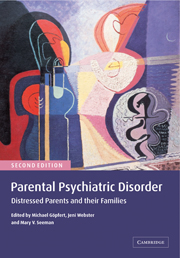Book contents
- Frontmatter
- Contents
- List of contributors
- Foreword
- Preface
- Part I Basic issues
- 1 What we want from adult psychiatrists and their colleagues: ‘Telling it like it is’
- 2 Parenthood and adult mental health
- 3 Parental psychiatric disorder and the developing child
- 4 Parental psychiatric disorder and the attachment relationship
- 5 The construction of parenting and its context
- Part II Comprehensive assessment and treatment
- Part III Specific disorders: the impact on parent–child relationships
- Part IV Specific treatments and service needs
- Part V Child-sensitive therapeutic interventions
- Part VI Models for collaborative services and staff training
- Afterword
- Index
- References
4 - Parental psychiatric disorder and the attachment relationship
from Part I - Basic issues
Published online by Cambridge University Press: 09 August 2009
- Frontmatter
- Contents
- List of contributors
- Foreword
- Preface
- Part I Basic issues
- 1 What we want from adult psychiatrists and their colleagues: ‘Telling it like it is’
- 2 Parenthood and adult mental health
- 3 Parental psychiatric disorder and the developing child
- 4 Parental psychiatric disorder and the attachment relationship
- 5 The construction of parenting and its context
- Part II Comprehensive assessment and treatment
- Part III Specific disorders: the impact on parent–child relationships
- Part IV Specific treatments and service needs
- Part V Child-sensitive therapeutic interventions
- Part VI Models for collaborative services and staff training
- Afterword
- Index
- References
Summary
Introduction
In contrast to the attachment of children to their parents and other important adults, the attachment of parents to their children has received little attention. Indeed it is not clear that the term ‘attachment’ should be used in the same way when referring to parents. However, consideration of the attachment of children to parents will lead to some indicators of the parental contribution to the attachment relationship, and to ways in which this might be threatened by parental mental illness, and what might be protective processes in the face of such threats.
Attachment – background
Bowlby's attachment theory (Bowlby, 1969) proposed that the child's early relationships with parents are internalized as ‘working models’ for later relationships. These early attachment relationships are characterized by attachment (proximity seeking) behaviour by the infant when there is a perceived threat or stressor such as the presence of a stranger, unfamiliar circumstances, tiredness or illness; and exploration from the ‘secure base’ of the parent, in general when the level of perceived threat is low. Although children's parents and other important caregivers are often referred to as attachment figures, it should be borne in mind that many other kinds of interaction take place between parents and children. These include ensuring safety and providing structure and discipline, and participating in joint activities such as play, games or conversation about each others' lives.
Keywords
- Type
- Chapter
- Information
- Parental Psychiatric DisorderDistressed Parents and their Families, pp. 50 - 61Publisher: Cambridge University PressPrint publication year: 2004
References
- 3
- Cited by



